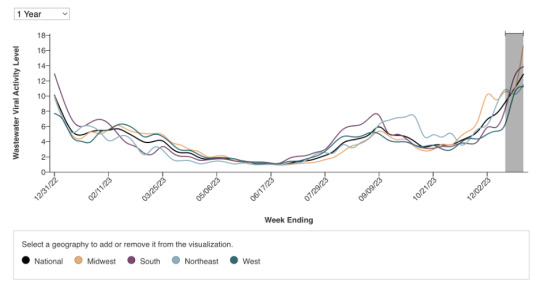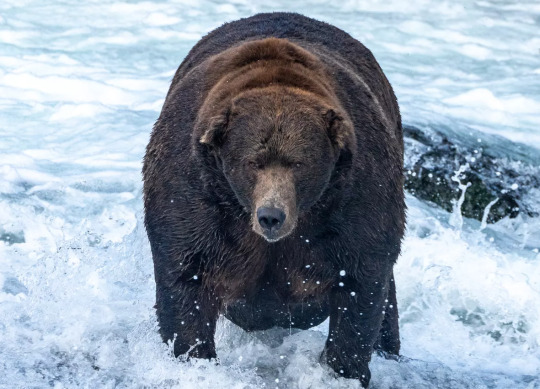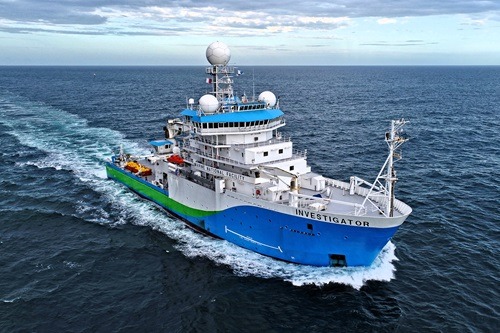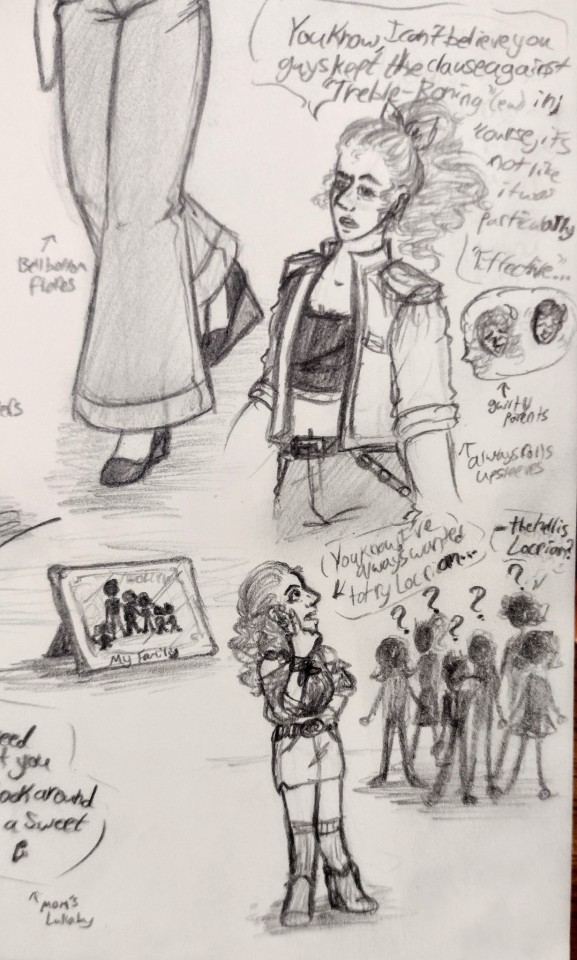#Prediction for National Weekly
Text
Live Ghana National Banker For 10/06/2023
Live Ghana National Banker For 10/06/2023
Check live Ghana lotto national banker from Abc Naija Lotto today and be rest assured of winning, National lotto banker two sure live drop.
Ghana best lotto banker National – premier lotto National live banker, Ghana National Lotto Key Setting Plan For Live Banker, Two Sure, Best Three & Perm.
National two sure – National Lotto forecast for 10 June 2023.…

View On WordPress
#Ghana National Lotto 2-Sure#Ghana national lotto 3direct#ghana National lotto banker#Ghana National Lotto Long Perm#Ghana National Lotto Perm7#Ghana National Weekly Lotto#live Ghana National banker#National 2Sure#National Lottery in Nigeria#Prediction for National Weekly
0 notes
Text
The Weather
All areas of the country are now at High or Very High levels of COVID Transmission.

According to the new CDC National Wastewater Surveillance System (NWSS) dashboard, all regions are experiencing increased COVID wastewater levels, with the Midwest being the highest. Nationally, wastewater levels are “very high.” Driven by the JN.1 variant, we are currently seeing the second highest wastewater levels since BA.1, the first Omicron wave in January 2022.

We continue to stress the importance of mitigating the spread of COVID, especially during this time of increasing transmission. Please continue to wear a high quality respirator mask (such as an N95) in indoor settings of any capacity, and postpone crowded events. In addition, make sure to take appropriate precautions when meeting with others.
Wins
Amidst this new surge, many hospitals – some responding to staffing shortages, and some responding to public pressure – have reinstated mask mandates.
We celebrate the work of organizers across the country including those at Care Not COVID Chicagoland, COVID Safe Maryland, COVID Advocacy NY, and MaskBlocs around the country who organized a call-in to hospitals last week to demand they reinstate – and make permanent – masking policies.
A coalition protest by Sacramento Jewish Voices for Peace, Sunrise Movement Sacramento, International Jewish Anti-Zionist network, Bay Area JVP, & Youth 4 Palestine Sac organized a fully masked (N95!) and tested (2 days in a row!) pro-Palestine protest at the CA State Capitol in Sacramento last week.
ACTUP’s New York chapter has voted to require and provide KN95 masks at all upcoming meetings and actions “due to the ongoing COVID-19 pandemic and recent surge, as well as to increase safety from surveillance at protests.”
Solidarity means we protect each other, and these organizers are showing us the way!
Variants
JN.1, a BA.2.86 descendent, is rising to prominence quickly in the United States. Nowcast estimates predict that by 1/6/2024, JN.1 will account for 61.6% of circulating variants. According to preliminary non-peer reviewed data, the newest (XBB.1.5) booster helps to protect against the JN.1 variant. Conversely, older vaccines did not offer significant protection against JN.1.
It is important to receive the updated booster, especially since uptake is currently low–according to a poll conducted by Gallup, only 29% of 6,000 participants surveyed received the updated vaccine as of December 7, 2023. This is in stark contrast to flu vaccine rates, polled at 49%. This is likely due to an imbalance in public health messaging–while efforts were poured into advertising the flu vaccine, not as much emphasis was placed on receiving the updated booster.

Hospitalizations
Weekly COVID hospitalizations continue to trend upward, now at 34,798 for the week ending December 30, 2023. The numbers for currently hospitalized patients with COVID are also increasing, currently at 25,430. In terms of regional trends, the Northeast and Midwest are seeing higher rates of hospitalization. When reviewing these numbers we must also remember that patients who are already admitted for other reasons and are suffering from nosocomial, or hospital-acquired infections, are not accounted for in this data.

Hospitals are overwhelmed. Healthcare workers are demanding support from administrators. Read this account of ER nurses at Montefiore Hospital in the Bronx who say that the hospital executives are refusing to open up vacant areas of the hospital to accommodate the surge in patients – leaving the ER dangerously overcrowded and forcing patients into hallway beds.
Long COVID
A new cross-sectional study published in Nature Communications found that Long COVID patients with post-exertional malaise (PEM) exhibit skeletal muscle changes that are exacerbated by exercise. PEM patients are also found to have unique pathophysiological changes, such as amyloid-containing deposits in muscle tissue. These findings contribute to mounting evidence that COVID infection can significantly damage the body, and more research is necessary in order to fully understand manifestations of Long COVID. If readers are curious, summarized findings can be found in this X (Twitter) thread, penned by one of the authors.
Long COVID research is important. This is why it is essential that all Long COVID research centers adhere to the strictest infection prevention protocols. Read this account of a person disabled by Long COVID who dropped out of a study because the study personnel refused to mask. We saw this same phenomenon last spring at Stanford during a study of Paxlovid’s impact on Long COVID rates.
Take Action
This week Jewish Currents put out a report on The Epidemiological War on Gaza, which amplified WHO’s January 2nd announcement that “there are currently 424,639 [reported] cases of infectious disease in Gaza,” an area with only 2 million residents total. With the ongoing destruction of hospitals and deprivation of food and water and environmental pollution from continued bombardment, the occupying forces have ensured the conditions for continued deaths even in times of ceasefire. Call your representatives and join a protest this week to demand a ceasefire and the reconstruction of Palestinian medical infrastructure towards fair health access for all peoples!
Let us support Massachusetts General Brigham Long COVID patients by telling the hospital to 1) meet all patient accessibility requests including wearing N95 respirators upon request and 2) make universal masking their new standard of care. They can be contacted through their contact form, or by calling 1-800-856-1983.
Rashida Tlaib sent out an email blast informing constituents of the current surge. The message included acknowledgment of COVID’s airborne nature, recommendation to wear a well-fitting mask, a link to access free tests through USPS, and information on updated vaccines and COVID transmission. Let’s contact Congresswoman Tlaib and thank her for this invaluable action!
Future Weather Reports
Starting next week, we will begin to publish the Weather Report on a bi-weekly basis. This will allow our team to focus on crafting action campaigns to push for a comprehensive public health approach to the pandemic, including mask mandates, paid sick leave policies, testing access, Long COVID research, next generation vaccines, indoor air quality regulations, and more. We hope to see you in our expanded actions to end the COVID pandemic soon to come!
#op#covid#covid-19#covid19#covid 19#coronavirus#covid pandemic#coronavirus pandemic#pandemic#covid news#covid isn't over#sars-cov-2#sars cov 2#long covid#people's cdc#pcdc#mask up#palestine#disability#ableism#covid variant#covid virus#covid variants#genocide#img#links#described in alt text
28 notes
·
View notes
Text


Investigating the contribution of gamma-ray blazar flares to neutrino flux
Blazars belong to the family of active galactic nuclei called quasars. What differentiates them from quasars is that the flares ejected out of these active galactic nuclei are pointed toward the Earth. These flares contain high-energy cosmic rays which are released from the core of these galaxies as jets spanning many light years. Such cosmic rays can interact with photons to produce subatomic particles called neutrinos.
Gamma-ray flares from blazars are thought to be the primary events behind neutrino detection in the sky. In 2017, the South Pole neutrino detector “IceCube” detected a high-energy neutrino event whose timings and positioning in the night sky coincided with the flare of a blazar called TXS 0506+056. Some scientists suggest that there could be a population of blazars whose flares are accompanied by high-energy neutrino emission. However, the relationship between blazar flaring activity and neutrino flux is yet to be properly understood.
In this regard, an international research team, led by Professor Kenji Yoshida from the Department of Electronic Information Systems at Shibaura Institute of Technology, Japan, has recently performed a comprehensive statistical analysis to understand the contribution of gamma-ray flares to neutrino emission. The team included Maria Petropoulou from the National and Kapodistrian University of Athens, Kohta Murase from The Pennsylvania State University, and Foteini Oikonomou from the Norwegian University of Science and Technology. Their paper was published in Volume 954, Number 2 of The Astrophysical Journal on September 6, 2023.
The researchers analyzed 145 blazars, 144 of them taken from the Fermi Large Area Telescope Monitored Source List and including TXS 0506+056, in this study. They first calculated a weekly average of the gamma-ray flux of the blazars and plotted their light curves. The team then derived the flare duty cycle (fraction of time spent in flaring state) and the corresponding energy fraction from these curves using a Bayesian blocks algorithm, a statistical method used to identify changes in a time series.
“We find that blazars with lower flare duty cycles and energy fractions are more numerous among our sample. Their flare duty cycles and energy fractions represent power law-like distributions, correlating strongly with each other. We found a significant difference between blazar subclasses for the flare duty cycles at the 5% significant level,” says Prof. Yoshida, highlighting the major results of their analysis.
The researchers evaluated the neutrino energy flux of each gamma-ray flare, using a general scaling relation for the neutrino and gamma-ray luminosities with a power law’s weighting exponent of 1.0–2.0, normalized to the quiescent gamma-ray or X-ray flux of each blazar. They also found that the gamma-ray flare distribution indicates that blazar neutrino emission may be dominated by flares for the weighting exponent >1.5. Furthermore, by comparing their neutrino predictions for each blazar for one-week and 10-year periods to the time-integrated IceCube sensitivity, the team placed upper limits on the contributions of the flares to the isotropic diffuse neutrino flux.
Prof. Yoshida remarks: “We hope that this study helps improve our understanding of the contribution of blazars to astrophysical neutrinos. Application of the present method to further observations might have the potential to contribute to the advancement of scientific knowledge of the origin of astrophysical neutrinos.”
TOP IMAGE....A new study suggests that high-energy neutrinos of blazars might be produced mainly during the gamma-ray flare phase. Credit NASA Goddard Space Flight Center from flickr (https://www.flickr.com/photos/24662369@N07/19578977022)
LOWER IMAGE....The data is for 129 blazars (97 FSRQs, 26 BL Lac objects, and 6 BCUs) for a 1 week bin (left) and a 10 yr bin (right) of scenario (2) with AX = 1.0, and γ = 1.5 as a function of the sin(δ) with decl. δ. Credit Kenji Yoshida from SIT, Japan
20 notes
·
View notes
Text


Bear 747- 2022 Fat Bear Week Champion
Choose the fattest bear of the year! Some of the largest brown bears on Earth make their home at Brooks River in Katmai National Park, Alaska. Brown bears get fat to survive and Fat Bear Week is an annual tournament celebrating their success in preparation for winter hibernation.
Fat Bear Week 2023 is October 4 - October 10. Your vote decides who is the fattest of the fat. Matchups will be open for voting between 12 - 9 p.m. Eastern (9 a.m. - 6 p.m. Pacific). Download your bracket to predict your own fat bear winner.
This is a single elimination tournament. For each match-up, vote for the bear you believe best exemplifies fatness. The bear with the most votes advances to the next round. Only one will be crowned champion of Fat Bear Week. Learn more about the history of Fat Bear Week.
2023 Fat Bear Week
This year, Fat Bear Week starts on October 4 and concludes on Fat Bear Tuesday, October 10. In addition to voting during this week-long tournament, there will be a series of online chats on explore.org featuring Mike Fitz, explore.org's resident naturalist, and rangers from Katmai. These chats focus on both the individual bears and Katmai's healthy ecosystem. Throughout the season, you can also tune in to the explore.org bear cams, which offer unprecedented access to the lives of the bears of Brooks River. There are also special live events on a variety of topics hosted weekly throughout the season.
Who's who in the bracket? We will reveal the bracket live here at 3 PM AKDT/7 PM EDT on October 2.
More photos can be found on Katmai's Flickr site.
Schedule of events:
October 2: Fat Bear Week bracket reveal live at 3PM AKDT/7PM EDT
October 3: Premiere of Fat Bear Week in the Classroom video series on explore.org
October 4: Live Chat at 3PM AKDT/7PM EDT– Welcome to Fat Bear Week*
October 4 – 10: Fat Bear Week voting open**
October 10: Live Chat at 3pm AK – Fat Bear Tuesday (end of Fat Bear Week)*
*All live chat events are hosted on explore.org live chat channel.
**All voting takes place at www.fatbearweek.org
[graphic, photo, and all information in this post from the Katmai National Park & Fat Bear Week websites]
#IT'S FAT BEAR WEEK!!!#fat bear week#fat bear week 2023#katmai bears#katmai national park#national park#national parks#bears#grizzly bears#animals#fat bears#polls#brackets#fun polls#fun brackets#cute animals#adorable animals#wild animals
26 notes
·
View notes
Text
Nanowrimo Tips
@everything.writing on IG
I really can’t believe Nanowrimo is fast approaching. 2023 has gone by so fast and we’re more than 75% of the way done with the year. October is coming to a close and November is approaching. Now is the season for pies, turkeys, and of course, NaNoWriMo. Whether this is your first time or you’ve done every one of them since they began, here is a list of tips to help you have a pleasant Nano experience.
First, what is NaNoWriMo? Whenever I post anything about Nano, I always get a bunch of questions asking what it is. It stands for National Novel Writing Month and happens every November. Writers challenge themselves and each other to write 50,000 words a month, which equates to 1667 words a day. You can go to Nanowrimo.org to participate.
Choose a story idea you’re excited about. A lot of people find themselves quitting their projects because they lose interest. While it might be hard to predict how you’ll feel about a project down the line, try to choose an idea you’re interested in, such as in your favorite genre. If you’re trying to continue an existing project, make sure you love it!
Break the monthly goal into weekly and daily goals. Thinking about writing 50K words is daunting and can make you tempted to procrastinate, so split it up into chunks of days and weeks. You can choose to write 1667 words every single day (I’ve done that), but it might benefit you to have some flexibility. One thing I find helpful is weekly goals such as 12K words a week so maybe you can write more words on weekends when you’re less busy. And remember that November is a whole month, so maybe you’re a little busier wrapping up some work deadlines at the beginning of the month, but then you go on Thanksgiving break. Or maybe you’re busier around the end of the month due to visiting family so you’ll write more in early November.
Be prepared by doing PrepTober. While you definitely don’t need to get every single detail down on paper, you should at least have an idea of your beginning, middle, and ending. This will make you more efficient since you’ll reduce the time you need to think. It can also make the process way less stressful.
Focus on getting the first draft done. Don’t edit as you go, because it’ll take more time. Instead, focus on getting the words down. You can edit later, but you can’t edit if you have nothing written. This might be hard to stomach for perfectionists, but you can absolutely edit in December.
Hold yourself accountable. Some people like having writing buddies to share progress, while others like to post their progress on social media. Whatever works for you and keeps you motivated. If you’re self-motivated, you can also keep a journal of how many words you wrote a day.
Work in places that promote productivity. This looks different for everyone. Some like to listen to music, others like writing in silence. Whether you prefer writing at a desk or on the couch, this is all up to personal preference. What normally makes you more productive?
Don’t stress too much. If writing 50K words is too much for you to handle, you can set your goal lower like 20 or 30K. November is a hectic month for some people, with work, school, and family. Unless you’re a full-time writer, you likely have some responsibilities more important than writing. It’s ok to put writing on the backburner if it’s affecting your ability to get some of them done or negatively impacting your mental health.
If you’re participating in Nano this year, I wish you the best of luck. If you’re not, then I wish you luck with your writing and life goals this month. Don’t hesitate to comment if you have questions, and I hope you enjoyed!
9 notes
·
View notes
Text
Item #: SCP-•721
Object Class: Keter
Special Containment Procedures: Anomalous object must be contained in separate universe, away from any forms of life. One(1) D-Class personnel will be sent out weekly to make sure they are still there and healthy. If anomaly escapes containment, SCP-••42 is to be contacted immediately to re-contain. Anomaly is to be contained within universe created by SCP-••42. If anomaly is detected outside this universe, contact SCP-••42 to have them re-contain. There is not to be any Foundation staff or D-Class found going to this universe.
Description: SCP-•721 is an anomaly that calls themselves 'Terri'. They can change forms, however their main form is an adult human of American nationality and is approximately 1.8 meters in height. They have purple hair with a large ponytail that falls to their waist, and two large, light blue eyes. The irises are capable of shrinking when anomaly becomes increasingly happy. They have black cat ears and no sign of human ears, along with a short black tail. They are capable of flight, seemingly by warping the gravity around them, and have shown to defy the laws of physics of multiple universes, similar to what has been shown by SCP-••42, but to a lesser extent.
When SCP-•721 hangs around someone for long enough, they will start getting increasingly obsessed over them, to the point of ripping through reality to get to them and attempting to abduct them so they won't leave each other. If this gets too far, they will enter a state they describe as 'MANIC', which has been shown to make them able to read one's mind to predict what they are about to do, letting them avoid it completely, although this does not happen when focused on something other than dodging. However, their body will start to phase out of our reality and back in, causing them to grow unstable. If the target is killed, SCP-•721 will enter an enraged state, attempting to seek revenge, however this is often stopped by SCP-••42, who seems to be connected to them in some way.
#pixels lore#i wrote an entire scp document for this character#just to show that theyre very much linked with the foundation#by the way scp-••42 is Pixel
5 notes
·
View notes
Text
Weekly Reading Update (07/24/23)

Reviews and thoughts under the cut
The Poppy War by R. F. Kuang (10/10)
This book is pretty much perfect. The plot is engaging, the characters are all amazing, the writing style hits hard, and there’s really good social commentary that touches on, honestly, almost every issue out there. Rin has got to be one of my favorite protagonists of all time; she’s the underdog, she’s easy to root for, and our desire for her to succeed almost makes us overlook her glaring flaws. Kuang establishes Rin’s overwhelming need to succeed, to win, to be the last one standing from the very beginning, and it leads to her slow but steady downfall as she must decide how far she is willing to go for the sake of her nation. Rin’s time in Sinegard is an interesting and unique twist on the fantasy school setting, and the tone switch between the time at Sinegard and the time at war is done masterfully. Even the war takes an incredibly dark turn, goes farther than the reader would ever expect, as Kuang draws from real history to write horrors that should’ve been beyond anyone’s imagination. Perhaps the most technically amazing part of this book is that even when she has fallen so far, part of us agrees with Rin; which is the danger of it all, isn’t it?
Neverseen by Shannon Messenger (8/10)
I have now officially reread all of the KotLC books I got through previously. Going into Lodestar will be uncharted territory for me, and wow am I glad I refreshed my memory. I forgot a lot of stuff, so it was almost like I was reading it for the first time. Like I predicted, this was a slower one, mostly filled with finding out more about the Black Swan and the Council, and there was a lot of Sophie and her friends wanting to do things that were "too dangerous." I won't lie, it dragged a bit, but it really picked up once Sophie started attending Exilium. I think the twins are a much-needed addition to the main cast to help shake things up and keep the dynamic from getting too worn out. Also, Calla is a particularly strong side character. While I could predict the broad strokes of the story, the actual method of getting there took me by surprise, and there's a huge twist at the end that totally restructures how the rest of the series is going to look. I'm very excited to start Lodestar!
Half Upon a Time by James Riley (8/10)
I loved this series as a kid, and rereading it was like returning home. It's actually so funny that this book has tons of tropes I love today just in a middle grade format. There's a pretty good level of intricacy to the plot, and the fairy tale elements are tons of fun. There are plenty of familiar characters that each have a unique twist to their story, often intertwining their stories with each other. For example, the Huntsman from Snow White is also the woodcutter/hunter from Little Red Riding Hood. This book also has a fun twist by being from the perspective of the character who guides someone who has fallen into another world. In most other books, May would be the main character, so having Jack tell the story subverts some expectations. The way Jack, May, and Philip interact is a little typical for the genre and time period, though I appreciate that it is heavily implied that Philip has no romantic interest in May. Finally, Jack's mysterious involvement with the Eye and his sword is one of my favorite parts of the book, and it's a pretty fresh concept.
The Serpent and the Wings of Night by Carissa Broadbent (CR, 20%)
I've barely progressed on this one, but I did make it to the end of the first trial, and I like how it was executed. Despite being a physically-based trial, there's a twist that allows Oraya to succeed through her wits, which makes infinitely more sense when she's up against vampires and demons. It also helps that Raihn is obviously gunning for an alliance with her, so he's more inclined to help her out. About the alliance, why Raihn specifically wants to team with Oraya is a pretty good one and honestly a more logical decision than I expected. However, Oraya turning him down made no sense to me. She's gonna have to team up with someone eventually, and Raihn seems like the lesser evil by far.
Strange the Dreamer by Laini Taylor (CR, 3%)
I've only just barely started this book, but I'm excited! I'm reading it with some friends, and the beginning seems quite interesting. I'll have some more in-depth thoughts next week once I've progressed more.
#books#reading update#the poppy war#r f kuang#neverseen#kotlc#half upon a time#the serpent and the wings of night#strange the dreamer
9 notes
·
View notes
Text
By James Meadway who hosts the weekly economics podcast Macrodose and is director of the Progressive Economy Forum. Previously, he was economic adviser to the shadow chancellor, and chief economist at the New Economics Foundation. Originally published at OpenDemocracy.
The working assumption, for governments and central banks across the world, is that at some point soon everything will get back to ‘normal’ – our economies will return to either pre-pandemic or, sometimes, even pre-2008 crash levels.
These beliefs are reinforced by media economics commentary and across political parties.
But what if they’re wrong? The world’s largest asset manager, overseeing $10trn in assets across the globe, thinks we are, instead, entering a period of increased risk and uncertainty, defined by unavoidable recession and much higher inflation.
BlackRock – a well-connected, influential and hugely profitable pillar of global capitalism – made the predictions in its ‘2023 Global Investment Outlook’ report.
It states: “The Great Moderation, the four-decade period of largely stable activity and inflation, is behind us.”
Instead, BlackRock forecasts a new regime with a “brutal trade-off” – falling living standards for the many becoming profits for the few.
This reality, of a world undergoing fundamental transformations and disrupting our settled modes of existence, has so far barely entered the economic mainstream.
For BlackRock to break with this consensus might, potentially, be one of the first signs of a broader shift in how major institutions in the Western economies view the world.
Systemic chaos
Annual food inflation in the UK rose to 13.3% – an all-time high – last month, according to trade body the British Retail Consortium, ahead of the official government figures out later this month.
This situation – though slightly worse in the UK due to a flawed Brexit deal and the falling value of the pound (critical as a major food importer) – is common across the globe. Even as wholesale energy prices have dropped from their summer 2022 peak, the price of food everywhere is soaring. United Nations’ forecasts show a major risk of widespread famine in the Global South over the next year, with harvests continuing to underperform.
This global spike in prices over the past 18 months was initially described by the economic establishment as “transitory”. Then, as inflation continued remorselessly upwards, familiar explanations reappeared: notably, excessive worker power (but real wages in the Global North are still falling) and excessive printing of money through quantitative easing (but we’ve been running QE since 2009).
The economic profession as a whole, and institutions such as the major central banks, have typically written down the obvious evidence of global instability as temporary factors, rather than something more systemic.
This means we’re trapped with central banks that still think pushing up interest rates to induce a recession is a smart way to bring down inflation. We have governments committed to holding down wages and salaries while allowing profits to explode.
But BlackRock believes the world is now “shaped by supply that involves brutal trade-offs” – in other words, the world economy is less effective at supplying goods and services than it was.
The after-effects of the pandemic have caused supply chain problems, as we all know, but they also think an ageing population means fewer workers, pushing up the cost of labour; that “geopolitical tensions” will disrupt global supply chains; and that the shift to net-zero carbon emissions will involve “demand and supply mismatches”.
Put all this together, and BlackRock thinks inflation will come down to the 2% level we’ve been used to only if central banks are prepared to ‘crush’ their economies into a severe recession. Since that’s unlikely, inflation will stay much higher than we are used to – combined with a miserable recession over the next year or so.
Massive profits for the lucky few
But BlackRock’s predictions don’t cover everything.
Its report misses the longer-term effects of Covid – both in terms of the impact on healthcare and, as we’re currently seeing, continuing waves of infection. It also misses, critically, the wider ecological impacts of climate change, biodiversity loss and resource depletion.
It is possible to imagine a world where peace returns rapidly to Ukraine, and the subsequent disruptions to global food and fertiliser trade are reduced. It is not possible to imagine a world where climate change and ecological destruction are thrown into reverse – indeed, some of the effects felt today, notably, biodiversity loss, are irreversible.
This twofold combination has led ecologist Nicholas Beuret to describe a “climate supercycle” of food shortages and rising prices running well into the future. (A recent episode of my podcast ‘Macrodose’ examines the coming food shortages for UK farmers.)
And, finally, BlackRock misses the extreme profits that shortages over the last year have generated for a select few multinationals, such as those supplying oil and gas.
It’s the last part that’s critical. A more unstable world affects everyone, but it will affect everyone differently.
For most of us, on the wrong side of food price hikes and extreme weather, the future is not great. But for the lucky few, shortages have been turned, through price rises, into massive profits
25 notes
·
View notes
Text
Denialism from Top to Bottom
[ This is another essay I wrote for college, back in Summer 2023. ]
It is quickly becoming evident that mass anthropogenic climate change is the single greatest environmental problem of our time and has been for decades now. It is surprising, then, that so many continue to promote denial of the reality of climate change. As climate change has become more prominent, the topic of denialism has also become more prominent in scholarship. The body of work is large, spanning many decades and drawing from many fields. Some authors have focused on the ties between climate change denialism and certain groups or institutions, e.g., Congress, journalists, and pseudoscientists (Hansson; Harrison; Zehr). Many papers have also discussed a variety of mental processes that explain the behavior of climate change denial, including motivated reasoning, authoritarianism, emotional regulation, self-efficacy (Jylhä et al.), anti-reflexivity (McCright et al.), or social denial (Norgaard). Interestingly, many authors have noted that having right-wing politics, comorbid with a belief in free-market capitalism, is a predictor for a given individual subscribing to climate change denialism (Björnberg et al.; Hansson; Jylhä et al.; McCright et al.)
One phenomenon that has not received much attention is the source attribution effect. Furthermore, relatively few psychological studies have taken the social aspect into account. With this paper, I will examine the influence of the actions of industry and powerful individuals on climate change denialism, mostly in the United States. First, I will look at how think tanks, a prominent source of denialist rhetoric, promulgate denialism. I will then look at some connections between industry and politicians, another source. This will be followed by a psychological explanation for the right-wing public’s higher support of denial that draws on Hanel et al.’s description of the phenomenon of source attribution. Climate change denial is “well-moneyed and politically well connected” (Hansson 39). Industry and wealthy individuals ostensibly have considerable monetary and political power, and so it is important to examine the ways in which they affect our environment and society.
To start, one individual who is often brought up in the discussion of climate change denial is Charles Koch. Koch is an owner of Koch Industries, a multinational conglomerate involved in, among others, the petroleum and energy industries (“Charles Koch”). Of the three conservative think tanks Björnberg et al. mention, “the Heritage Foundation, the Cato Institute, and the Heartland Institute” (236), Koch has been involved in two. In 1977, he co-founded the Cato Institute, a think tank dedicated to disseminating the ideas of small government and free market through many channels, such as through news media, reports, and even podcasts (“About”). In 2006, they released a report that cast doubt on many predictions of climate change models, e.g., predictions about ice caps, freak weather events, or extinction rates. In doing so, they cast doubt on the computer models themselves as, apparently, they did not reflect reality (Michaels). This is similar to the phenomenon that Zehr describes of managing uncertainty. Instead of outright saying that nothing is happening, they point to flawed models as the reason for why there is uncertainty (94). In recent years, the Cato Institute has laid off the more extreme forms of denialism, but the same cannot be said about its spinoff, the Heartland Institute.
Founded by a former director of the Cato Institute, the Heartland Institute describes itself as “the pipeline between the freedom movement . . . and the nation’s 8,400 national and state elected officials” (“About Us”). Even a cursory search for ‘climate change’ on their website reveals over 200 pages of articles, as well as two recurring segments called “Climate Change Roundtable” and “Climate Change Weekly” that are dedicated to promoting climate change denialism (“Browse Heartland”). One recent article entitled “[Fill in the Blank Climate Crisis] Season is Here” furthers uncertainty around climate change by expanding the problem (Burnett). That is, by bringing up new topics such as allergy season or maple syrup production, they promote the idea that scientists are not certain, and the science is not settled as it is always coming up with something new (Zehr 93). It is evident that rhetoric advanced by conservative think tanks is a key way that industry and powerful individuals can promote their interests, both to policymakers and to the public, by spreading climate change denialism.
Think tanks and policy centers are far from the only way that industry can influence legislators. Often, more direct methods are used. Although the diffusion of authority in the United States’ institutions can be an obstacle to climate change policy, it can also facilitate it. When favorable policy does manage to pass, the system can work to prevent backsliding (Harrison 77). Therefore, the gridlocked legislative system alone cannot explain why climate denialist policy is far more common than the alternative. Instead, connections between industry and policymakers must be taken into account. Although not her focus, Harrison gives examples of industries pressuring the legislature into acting a certain way. After the United States accepted its target during the negotiations for the Kyoto Protocol, a full 31% reduction in emissions, a group consisting of industry, businesses, and trade associations, led in part by the American Petroleum Institute, strongly voiced their opposition to Kyoto (68). Lamont Hempel, documentary filmmaker and chair of Redland College’s Sustainability Council (who has since passed), reported that “Congress bow[ed] to pressure from the fossil fuel lobby and energy-intensive industries” (qtd. in Harrison 78).
The lobbying efforts were not constrained to one party, however. Although the majority of funding from fossil fuel companies went to the Republican party, the Democrats were also lobbied by their local industries— “oil in Louisiana, coal in West Virginia, and automobiles in Michigan” (Harrison 79). Looking at statistical data gathered over the past 30 years, the Democratic party has received approximately 20% of all oil and gas contributions, while Republicans have received approximately the other 80% (“Oil and Gas”). It is clear, then, that the disparity between the types of bills passed is due, in part, to industry pressure. While not the attitude of climate change denialism per se, legislation that treats climate change as a non-issue still denies the reality of climate change and favors the corporations and associations that benefit from the continued use of fossil fuels.
On top of lobbying, policymakers themselves can have personal ties to industry. Harrison notes that “Bush was a former Texas oilman and his vice president was formerly the CEO of the world’s largest oil field” (76). Along with the party leadership, many other Republicans during the Bush administration also had connections to the petroleum industry: people such as White House editor Philip Cooney, former lobbyist for the American Petroleum Institute who left to go work with ExxonMobil, and James Inhofe, the man who peddled the conspiracy theory that climate change was invented by weather channels (86) and has connections to both Charles Koch and the Heritage Foundation (“James Inhofe”). When the economy of a region, or the profit of a corporation, is heavily dependent on processes that exacerbate climate change, the full acknowledgement of climate change can be a threat to profits. Hence, those corporations or individuals can use their considerable resources to implement policy that is beneficial to them. This phenomenon is by no means exclusive to the United States; Norgaard mentions how central natural gas is to the Norwegian economy (349) and how Norwegian policy has favored that industry (365).
Having discussed how wealthy individuals and industries reliant on fossil fuels spread their message through policy centers and politicians, I will now look at a way this affects the public through a psychological lens. The source attribution effect, put simply, is when one is more affected by the source of some information rather than the content. In a series of four experiments, Hanel et al. presented two groups that stereotypically have opposing worldviews with either correctly or incorrectly attributed aphorisms. That is, Christians and atheists were presented with either a Bible verse or a quote from a Greek philosopher, while Democrats and Republicans were given quotes from each party’s presidential candidates (53). What they found was that “the actual origin of the aphorisms did not matter” (56). Christians tended to agree with a statement when it was attributed as a Bible verse, while atheists were more likely to disagree, in spite of the actual source of the quote. More relevantly, this same effect was also observed in the experiment consisting of Democrats and Republicans. A given individual tended to agree with a quote attributed to a member of the party they identified with, even if the quote actually came from the other party (58). This pattern is also not exclusive to the United States. Hanel et al. replicated the experiment in the United Kingdom, with quotes from Conservative and Labour MPs, and found similar results (60).
The source of claims and attitudes about climate change denial are, therefore, crucial to explaining why a certain demographic might lean one way or the other. As discussed previously, a large part of climate denialist rhetoric stems from these conservative Anglophone think tanks and policy centers that often have considerable right-wing funding. Conservative news presenters, podcast hosts, journalists, and politicians appeal to other conservatives because of the source attribution effect. When Bush cited “the incomplete state of scientific knowledge” (Harrison 85), right-wing members of the public—largely Bush voters themselves—were more likely to agree with the claim the science is incomplete. When Republican senator James Inhofe put forward the idea that climate change was a conspiracy made up by weather channels (86), average Republicans were more likely to agree simply because the source was also a Republican.
Although many studies have focused on psychological factors, relatively few have taken the social aspect into context. The source of typically climate denialist claims and attitudes are equally as important as individual predilections. A large part of denialist rhetoric ultimately comes from industries that rely on climate change exacerbating processes, such as the American Petroleum Institute or the Norwegian natural gas industry, or wealthy individuals, like Koch, who have financially benefited from fossil fuels. This rhetoric, one that serves to keep regulation and intervention out of these ventures, is spread by well-funded think tanks and policy centers to both politicians as well as members of the public. The politicians are thus compelled to enact policy that benefits the industry. In addition, politicians that have ties to industry, especially conservative ones, also spread the same rhetoric to their party base. Those in the base, right-wing members of the public who support right-wing politicians, are in turn more likely to believe such rhetoric simply because it is coming from a source in the in-group. This article could not consider every aspect of the transmission from corporation to the public. The roles of other actors, such as activists and scientists, also need to be examined. The state of conservative think tanks in other Anglophone countries could also be explored. In addition, energy-intensive industries and wealthy individuals are just one aspect of the capitalist system. As such, studies focusing on other aspects, such as the propaganda model of media or false consciousness, and their relation to climate change denialism might also be beneficial. With climate change arguably being the most important environmental issue of today, affecting the entire planet, it is important to understand its denial from a multitude of angles. In addition to psychological or sociological effects, looking at broader systems and power dynamics is critical. As capitalism is the social, political, and economic status quo currently, it is necessary to examine all the ways in which it affects our environment and our society.
References
“About.” Cato Institute, 2023, www.cato.org/about. Accessed on 22 June 2023.
“About Us.” The Heartland Institute, 2023, www.heartland.org/about-us. Accessed on 22 June 2023.
Björnberg, Karin Edvardsson, et al. “Climate and Environmental Science Denial: A Review of the Scientific Literature Published in 1990-2015.” Journal of Cleaner Production, vol. 167, 20 November 2017, pp. 229-41, doi.org/10.1016/j.jclepro.2017.08.066.
“Browse Heartland.” The Heartland Institute, 2023, www.heartland.org/?s=climate+change. Accessed on 22 June 2023.
Burnett, H. Sterling. “[Fill in the Blank Climate Crisis] Season Is Here.” The Heartland Institute, 21 March 2023, www.heartland.org/opinion/climate-change-weekly-465-fill-in-the-blank-climate-crisis-season-is-here. Accessed on 22 June 2023.
“Charles Koch.” DeSmog, 25 June 2021, www.desmog.com/charles-koch. Accessed on 22 June 2023.
Hanel, Paul H.P., et al. “The Source Attribution Effect: Demonstrating Pernicious Disagreement between Ideological Groups on Non-Divisive Aphorisms.” Journal of Experimental Social Psychology, vol. 79, November 2018, pp. 51-63, doi.org/10.1016/j.jesp.2018.07.002.
Hansson, Sven Ove. “Science Denial as a Form of Pseudoscience.” Studies in History and Philosophy of Science, vol. 63, June 2017, pp. 39-47, doi.org/ 10.1016/j.shpsa.2017.05.002.
Harrison, Kathryn. “The United States as Outlier: Economic and Institutional Challenges to US Climate Policy.” Global Commons, Domestic Decisions: The Comparative Politics of Climate Change, edited by Kathryn Harrison and Lisa McIntosh Sundstrom, The MIT Press, 2010, pp. 67-103, doi.org/10.7551/mitpress/9780262014267.003.0003.
“James Inhofe.” DeSmog, 18 April 2023, www.desmog.com/james-inhofe. Accessed on 22 June 2023.
Jylhä, Kirsti M., et al. “Science Denial: A Narrative Review and Recommendations for Future Research and Practice.” European Psychologist, 13 December 2022, doi.org/10.1027/1016-9040/a000487.
McCright, Aaron M., et al. “Ideology, Capitalism, and Climate: Explaining Public Views About Climate Change in the United States.” Energy Research and Social Science, vol. 21, November 2016, pp. 180-9, doi.org/10.1016/j.erss.2016.08.003.
Michaels, Patrick J. “Is the Sky Really Falling? A Review of Recent Global Warming Scare Stories.” Cato Institute, 23 August 2006, www.cato.org/policy-analysis/sky-really-falling-review-recent-global-warming-scare-stories#. Accessed on 22 June 2023.
Norgaard, Kari Marie. “‘We Don’t Really Want to Know’: Environmental Justice and Socially Organized Denial of Global Warming in Norway.” Organization and Environment, vol. 19, no. 3, September 2006, pp. 347-70, doi.org/10.1177/1086026606292571.
“Oil and Gas: Long-Term Contribution Trends.” OpenSecrets, n.d., www.opensecrets.org/industries/totals.php?ind=E01. Accessed on 22 June 2023.
Zehr, Stephen C. “Public Representations of Scientific Uncertainty about Global Climate Change.” Public Understandings of Science, vol. 9, no. 2, 1 April 2000, pp. 85-103, doi.org/10.1088/0963-6625/9/2/301.
2 notes
·
View notes
Text
National Lotto Free Banker For Today 02/09/2023
National Lotto Free Banker For Today 02/09/2023
National lotto free banker for to today is the best ever trusted national live banker and we are sure Abc Naija.Com lucky banker for today will drop live.
National predictions is coming with our best Ghana national two sure predictions and we are very sure of winning today, make sure you don’t miss it.
Ghana lotto live forecasting 2sure – Forecast…

View On WordPress
#2sure live banker for National lotto#2sure today National live#baba ijebu National banker#Banker For Today National lotto#Ghana Lotto Prediction for National#ghana National 2sure#Ghana National Lotto 2-Sure#Ghana National lotto 2sure key#Ghana national lotto 3direct#ghana National lotto banker#ghana national lotto forecast#Ghana National Lotto Forecaster#Ghana National Lotto Long Perm#Ghana National Lotto Perm7#Ghana National Weekly Lotto#king live banker for today National#live Ghana National banker#live national banker for today jet#National 2 live banker for today lotto#National 2 sure today live#National 2Sure#National best lotto banker for today#National best numbers to play today#National Confirmed Two Sure#National ghana live banker#National Ghana lotto forecast for today#National ghana lotto live#National live banker#national live banker for today#national lottery authority ghana
0 notes
Text
I need to talk about one of my musical obsessions with you:
Hearts of Space
Hearts of Space is a public radio program started by Steven Hill in 1973 in San Francisco, and nationally syndicated in 1983. They broadcast what they call "space music" ambient and down tempo, selective classical, and world music that evokes a sense of boundless space. A sense of being among the stars or in quiet internal contemplation. To be a late night center of calm on a Friday night. Music that was both timeless and cutting edge.
Because they were on the bleeding edge of an electronic music technological revolution, they also had access to and interest in the internet and high hopes for its potential for human connection and direct arts interactions. They had a website by 1994 were part of Usenet. In 1999 they were first broadcast on a new thing called online public radio stations. In 2001 (2001!!) they began one of the earliest music subscription services for their program archive, then 28 years of programs with with playlist, artist, album, and where to buy the music (most of their music is small label and especially in the early days finding disks could be hard.) They also owned their own music label for a while to get this music made. Their website still has the aesthetic of a nerdy artist website of 2001 (in a very affectionate way).
If you want to have your mind blown, read this 2005 Very Long Interview with Steven Hill where he accurately predicts where digital music is heading in the next 0 years. It was there on the ground watching and interacting with both recent developments and what people's dreams and ambitions for it were. He was right about what people wanted and how the music industry would change to reflect that. It's like reading a prophecy.
Their weekly program can be listened to once for free, with a ton of different tiers for budget value with increasing access (but all good experiences, I've used most of them). Basically a bespoke Patreon system long before Patreon existed. They've always had direct control of their work and survived the volatility of middle men because of it. They've been artist-first, too, and have always tried to reduce friction for people to buy the music they play and directly find and support the artists. A very different mission than a platform like Spotify (founded a year after this interview).
One of my favorite things is Steven Hill starting each program with a music appreciation monologue contextualizing the selections and pontificating about the larger world in his incredibly smooth beautiful late night radio voice. Sometimes it's exploring a particular artist or a musical movement, or just the feeling of frost in winter. I learn a lot from them and they really set the mood (but also on high paid tiers you can turn them off if you're using it as sleep or study music).
There's a free three day pass to all the features and you can buy premium access in chunks of 10 hours if you only listen occasionally.
If you love ambient music in all its forms, definitely check this program out. It's such a great way to discover new music. Great music to game, too. (There have been two programs of video game music with guest curators Nerd Noise Radio.)
4 notes
·
View notes
Text

FFXIV WRITE 2023; PROMPT 3: FREE WRITE // SNOW
The two soldiers sent to her had crisp presentations, she’d give them that. Their uniforms were all pressed to standard and free of any snowfall from outside, hats firmly secure above their…unseemly horns. Their salutes were at perfect angles, despite how hard it must be to get into proper positioning with scales all over their bodies. She would have been impressed, if she could have tolerated looking at them for longer than necessary.
It was no secret that most Garleans harbored suspicions about the nature of the conscripted soldiers and annexed people brought into the Empire, and Hanne was no exception. She was only slightly mollified by knowing that even though she held only a minor public official rank, she could have these beasts deferring to her as they would a superior military officer. Oh, she was sure it angered them — especially the Auri male with the light-colored horns who hadn’t stopped glaring at her the moment he entered the office space — but there was etiquette to observe for these particular situations, and she would gleefully follow it.
So it was with a tiny smirk that she merely nodded her head at their salute, before smugly asking, “I trust you have the documents I need? Optio Ulfila wouldn’t have sent you all this way empty-handed when he knows how busy we’ve been lately. I thought this would be a task even a child could handle quickly, but you’ve been even slower than I expected, and I expected very little from you to start.”
“...Yes, my lady. Here they are. We apologize for the delay.” It was the pale-skinned one with night-black scales that answered her in his composed and accented manner; a wise decision, to be sure. Hanne had the perception that had his companion responded, she would not have heard anything so carefully courteous. She had heard about these two before in passing gossip, something about how they were always together and worked as efficiently as any machine unit, but she didn’t trouble herself with any specific details about the pair. As far as she was concerned, the less she saw of these foreigners, the better.
The one who spoke held out the requested papers to her, but all she did was stare at his hand for several long seconds; it took that long for him to realize his “mistake” — it was considered distasteful to most to have direct contact between citizens and non-citizens. When he understood, he moved forward to lay the forms down in the center of the desk Hanne was sitting behind. He gave her a polite smile before stepping back into his original spot beside the other man.
She made a show of picking up the documents and combing through them slowly, reading each page as if they contained highly-classified state government secrets and not the usual weekly report on ordered rations and personal letters from home. Hanne did not so much as look up at them during this entire performance; she would be willing to bet that the more aggressive one would break the silence if she waited long enough.
“...Is that all? Can we leave? This is taking too long.” The much rougher voice was quieter than she expected it would be, as it clearly was not meant for her to overhear. There was a swift shushing sound after that, followed by a hurried and low conversation between the two that she could not quite make out words to, but could guess the contents of. She had to quickly hide her face behind the papers in her hands so that she could laugh. Savages were so predictable.
“Is there anything more important than contributing to the prosperity of our great nation? You should be more grateful for the chance to prove your loyalty. One day the rest of your kind will come to view you as role models, if all goes well on the frontlines and we can show them the peace and freedom to be found when you join with Garlemald.” Though there was a tease to her voice, projected purposely louder to make it clear that she was responding to the whisper, there was also a bite to it; a warning she did not need to emphasize with more blatant threats.
For a moment, Hanne thought that the larger Au ra would leap across her desk and attack her, so primed for a violent outburst to her taunt as he appeared to be, but he was held back by a tight grip on a forearm by his peer. No one moved then, all three sets of eyes locked on each other, waiting for the first sign that the tension would break one way or the other.
Well, let no one say she couldn’t be gracious to even the lowest among them every once in a while.
With an affected sigh, she lazily reclined back in her seat and flicked a wrist in the air, as if brushing them aside. “You may leave. Tell your commander that I want my reports delivered to my desk before the work day begins next time. If it means standing outside and waiting to be let in, then so be it; at least I know I’ll have what I need on time. Oh, and tell him I want you both to do it. You can tell him I am…interested in seeing your growth. He’ll understand, I’m sure.”
The men turned their heads to one another and shared a long look, communicating everything they needed to say through that alone. Quicker than when she had made them wait, they simultaneously faced her and smartly saluted her again, and with practiced emotion exclaimed, “Glory be to Garlemald!”
It would not do to appear to meet their apparent passion with less fervor, so she rose from her chair and echoed the same phrase and salute, wry grin spreading on her face.
Glory be to Garlemald, indeed.
#ffxiv#ff14#ffxivwrite#ffxivwrite2023#hanne bishop#seran shirasagi#nobutada ittetsu#ruins of rin#sexykunai#ffxiv midlander#ffxiv au ra
3 notes
·
View notes
Text

New SpaceTime out Monday...
SpaceTime 20240304 Series 27 Episode 28
Odysseus lunar lander placed into sleep mode
Intuitive Machines will place their Odysseus Nova-C lunar lander into sleep mode in the hope of waiting out the 15 Earth day long lunar night following its sideways touch down last week near the Lunar south pole.



The Atlantic Ocean could start to disappear in 20 million years.
A new study suggests the Atlantic may ‘soon’ enter its declining phase. The findings reported in the journal Geology are based on new computational models which predict that a subduction zone currently below the Strait of Gibraltar will propagate further inside the Atlantic Ocean and contribute to forming an Atlantic subduction system – an Atlantic ring of fire.





Three new moons discovered around Uranus and Neptune
Astronomers have discovered three tiny new moons orbiting the ice giants Uranus and Neptune.




The Science Report
A new study claims zinc could help some people with cystic fibrosis.
An investigation has solve the 120 year old maritime mystery of the SS Nemesis.






A new study has failed to find any clear link between the weather and back, knee or hip pain.
Skeptics guide to the truth behind the Amityville Horror
SpaceTime covers the latest news in astronomy & space sciences.
The show is available every Monday, Wednesday and Friday through Apple Podcasts (itunes), Stitcher, Google Podcast, Pocketcasts, SoundCloud, Bitez.com, YouTube, your favourite podcast download provider, and from www.spacetimewithstuartgary.com
SpaceTime is also broadcast through the National Science Foundation on Science Zone Radio and on both i-heart Radio and Tune-In Radio.
SpaceTime daily news blog: http://spacetimewithstuartgary.tumblr.com/
SpaceTime facebook: www.facebook.com/spacetimewithstuartgary
SpaceTime Instagram @spacetimewithstuartgary
SpaceTime twitter feed @stuartgary
SpaceTime YouTube: @SpaceTimewithStuartGary
SpaceTime -- A brief history
SpaceTime is Australia’s most popular and respected astronomy and space science news program – averaging over two million downloads every year. We’re also number five in the United States. The show reports on the latest stories and discoveries making news in astronomy, space flight, and science. SpaceTime features weekly interviews with leading Australian scientists about their research. The show began life in 1995 as ‘StarStuff’ on the Australian Broadcasting Corporation’s (ABC) NewsRadio network. Award winning investigative reporter Stuart Gary created the program during more than fifteen years as NewsRadio’s evening anchor and Science Editor. Gary’s always loved science. He studied astronomy at university and was invited to undertake a PHD in astrophysics, but instead focused on his career in journalism and radio broadcasting. He worked as an announcer and music DJ in commercial radio, before becoming a journalist and eventually joining ABC News and Current Affairs. Later, Gary became part of the team that set up ABC NewsRadio and was one of its first presenters. When asked to put his science background to use, Gary developed StarStuff which he wrote, produced and hosted, consistently achieving 9 per cent of the national Australian radio audience based on the ABC’s Nielsen ratings survey figures for the five major Australian metro markets: Sydney, Melbourne, Brisbane, Adelaide, and Perth. The StarStuff podcast was published on line by ABC Science -- achieving over 1.3 million downloads annually. However, after some 20 years, the show finally wrapped up in December 2015 following ABC funding cuts, and a redirection of available finances to increase sports and horse racing coverage. Rather than continue with the ABC, Gary resigned so that he could keep the show going independently. StarStuff was rebranded as “SpaceTime”, with the first episode being broadcast in February 2016. Over the years, SpaceTime has grown, more than doubling its former ABC audience numbers and expanding to include new segments such as the Science Report -- which provides a wrap of general science news, weekly skeptical science features, special reports looking at the latest computer and technology news, and Skywatch – which provides a monthly guide to the night skies. The show is published three times weekly (every Monday, Wednesday and Friday) and available from the United States National Science Foundation on Science Zone Radio, and through both i-heart Radio and Tune-In Radio.
#science#space#astronomy#physics#news#nasa#esa#astrophysics#spacetimewithstuartgary#starstuff#spacetime
7 notes
·
View notes
Text

This week's newsletter from AthensLive is out:
* What happened in Thessaly?
* How and why did Thessaly Plain drown?
* And now, what?
The situation in Thessaly Plain and surrounding areas is desperate. Lost lives, homes, and animals in the mud predict nothing but a grim next decade for these people and for the country as a whole, as the plain represents some 5.2% of the country’s GDP - in agriculture, forestry, and fisheries.
The road and rail network has been crippled. Even army bases flooded, raising questions about whether top army officers could protect the national defense.
Even worse is that the disaster could have been avoided. It has been predicted with great accuracy. But then, anti-flooding works were never implemented. This, along with government incompetence, did the job.
The next day will be really hard. How many disasters can this country take?
It cannot be recommended strongly enough to read and share this week's updates on the events and developments in Greece here:
https://steadyhq.com/en/athenslivegr/posts/40eeee0a-c6df-47fb-b988-b15edaec6671
For anyone with a wish or need to follow and to gain an insight into recent events in Greece and to read and support independent and investigative journalism in English, the weekly newsletter from AthensLive should be a core element in the reading flow.
If you want the best overview of the events and developments in Greece right now, this is the place to go. Not the mainstream Greek news, but independent journalism with sharp analysis and links to interesting and important topics from a variety of sources.
Become a member and get the newsletter in your inbox every week here:
https://steadyhq.com/en/athenslivegr/newsletter/sign_up
2 notes
·
View notes
Text

"I got my ticket for the long 'way round, the one with the prettiest of views; it's got mountains, it's got rivers, it's got sights to give you shivers, but it sure would be prettier with you..."
This oc has been living rent free in my head for weeks now and I'm about to make that everybody's problem! More about her, the concept that spawned her, close ups, and more below the cut; image id in the alt text!
(Also, for the record: they're girlfriends your honor 🥰.)
The Concept: alright I'm not gonna actually copy-paste the entire concept i have for this story here because it's long, so y'all are getting the quick and dirty tl;dr version from the get go. You're welcome. Tl;Dr: Pitch Perfect 4 but it's a next gen movie focusing on Bella (Stacie's daughter) as a senior at Barden and her adventures co-leading the Bellas and Treblemakers because the college has had some budget cuts and decided they didn't need four acapella teams and smushed the two rival groups together. Shenanigans ensue. Also there's a co-protagonist, Molly, an incoming freshman who's excited to join the Bellas because shock! Amazement! Not at all predictably, she's a Legacy just like Bella! (And unlike the rest of the teams actually they're all new except for one of the Treblemakers who's Donald the Rapper's son.) In fact, not only is she a Bella Legacy, she's technically a Treblemaker Legacy through her dad; her arc centers on the mystery of who could possibly be her parents among the original/second gen Bellas and Treblemakers?? (Admittedly it's not so much a mystery as it is a fakeout cause the clues dropped are just ambiguous enough to cause confusion on whether she's Emily's daughter--presumably with Benji based on the love of Star Wars--but close with Beca and/or Jesse as an aunt and uncle, or if she's Beca and Jesse's daughter who spent time with Uncle Benji and/or Aunt Emily. The answer is the latter btw the girl loves juice pouches way too much to be anything else but a Swanson.) The answer is revealed at the very end after the Bellas and Treblemakers have finally learned to work together and have won Nationals. We finally get the cameos from the original stars as they come to congratulate the new kids, including Stacie (who's very very proud of her daughter going out with a win!) and, of course, an absolutely ecstatic Jesse with a pair of twin boys in tow, followed shortly (after a brief but forceful phonecall with an assistant over a run-over flashdrive of music) by Beca.
The Characters: I say characters cause while it's mostly miss Molly taking up this page, there are a couple secondary characters that can be mentioned here too.
Molly (Swanson, tho that wouldn't be revealed at first): one of our two main characters, she's a 19-year-old freshman at Barden going into Music Education (she's always wanted to follow in her parents' footsteps into music but she's not particularly keen on being a celebrity like they are; she'd rather nurture a love of music through teaching, like her parents did for her). She's a veritable ball of sunshine with a love of juice pouches and Star Wars, has a near-encyclopedic knowledge of every single John Hughes movie (though Ferris Bueller's Day Off is her personal favorite rather than the Breakfast Club, something that she and her father have weekly play-fights over), a very sarcastic and dry sense of humor, and a love of mashups and remixing (and also checkered or plaid-patterned flannels); she is truly a mix of both her parents. She's also super excited to be a Bella! She doesn't mention she's Legacy to anyone but Bella (who she meets at the club fair and immediately clicks with) because she wants to get in on her own merits (rather than by being THE Beca Effing Mitchell's daughter), though that little tidbit of information quickly becomes impossible to hide when the first group activity they perform is to harmonize When I'm Gone and Molly's fully moved to tears. 🥺 Also of note, Molly is a Mezzo, a bit higher than her mother's Alto.
Bella Conrad: our other main character (and likely the one we would see first), this is none other than the same baby Bella from PP3! She's all grown up now at 22 and finishing up her senior year at Barden, and currently the only Legacy Bella (until Molly comes along of course) as well as a co-captain of the group along with a couple other seniors. She's much more reserved compared to her outgoing mother or the energetic Molly, but she's sweet in her own way and always eager to lend a helping hand or guide a new Bella into the group. She's a math major, intending to get a job teaching high school level math (something she and Molly bond over quickly). She is a Soprano.
Julian (Donald's son): a secondary character, he's the leader of the Treblemakers and a close friend of Bella's. He makes up the third leg of the little Legacy Trio and happily welcomes Molly into the group, subtly encouraging Bella to make a move on her quickly growing crush on the other girl as well as working as a voice of reason among the turbulent Treble-Bella combined team. He's very level-headed and holds rank as the best beatboxer on the team. Besides being a beatboxer, he is also a Baritone.
The Close Ups:




#pitch perfect#next gen oc#jeca#beca x jesse#jesse x beca#yeah the whole concept behind this is that you wouldnt know the ships until the end but i dont wanna die today sooo#we're just gonna lead with the ships#not like it wasnt obvious with her... everything. but. just in case.#myposts#myart#rare pair#also for the record molly ends up shipped with bella#havent decided if theyre lesbians or some other form of wlw but. yeah. gay. girlfriends.#im thinkin they go to atlanta pride together. maybe even with molly's parents (cause theyve been going to pride for years)#(cynthia rose first brought them but theyve been going independently to LA pride since before Molly was born)#(im a bi4pan Jeca truther if that wasnt clear)#oc: molly swanson#pitch perfect rare pair week#this is a bonus post cause i dont have anything for today's prompt unfortunately#so. have a Molly!#and a Bella!
9 notes
·
View notes
Text
I really can’t believe Nanowrimo is fast approaching. 2022 has gone by so fast and we’re more than 75% of the way done with the year. October is coming to a close and November is approaching. Now is the season for pies, turkeys, and of course, NaNoWriMo. Whether this is your first time or you’ve done every one of them since they began, here is a list of tips to help you have a pleasant Nano experience.
First, what is NaNoWriMo? Whenever I post anything about Nano, I always get a bunch of questions asking what it is. It stands for National Novel Writing Month and happens every November. Writers challenge themselves and each other to write 50,000 words a month, which equates to 1667 words a day. You can go to Nanowrimo.org to participate.
Choose a story idea you’re excited about. A lot of people find themselves quitting their projects because they lose interest. While it might be hard to predict how you’ll feel about a project down the line, try to choose an idea you’re interested in, such as in your favorite genre. If you’re trying to continue an existing project, make sure you love it!
Break the monthly goal into weekly and daily goals. Thinking about writing 50K words is daunting and can make you tempted to procrastinate, so split it up into chunks of days and weeks. You can choose to write 1667 words every single day (I’ve done that), but it might benefit you to have some flexibility. One thing I find helpful is weekly goals such as 12K words a week so maybe you can write more words on weekends when you’re less busy. And remember that November is a whole month, so maybe you’re a little busier wrapping up some work deadlines at the beginning of the month, but then you go on Thanksgiving break. Or maybe you’re busier around the end of the month due to visiting family so you’ll write more in early November.
Be prepared by doing PrepTober. While you definitely don’t need to get every single detail down on paper, you should at least have an idea of your beginning, middle, and ending. This will make you more efficient since you’ll reduce the time you need to think. It can also make the process way less stressful.
Focus on getting the first draft done. Don’t edit as you go, because it’ll take more time. Instead, focus on getting the words down. You can edit later, but you can’t edit if you have nothing written. This might be hard to stomach for perfectionists, but you can absolutely edit in December.
Hold yourself accountable. Some people like having writing buddies to share progress, while others like to post their progress on social media. Whatever works for you and keeps you motivated. If you’re self-motivated, you can also keep a journal of how many words you wrote a day.
Work in places that promote productivity. This looks different for everyone. Some like to listen to music, others like writing in silence. Whether you prefer writing at a desk or on the couch, this is all up to personal preference. What normally makes you more productive?
Don’t stress too much. If writing 50K words is too much for you to handle, you can set your goal lower like 20 or 30K. November is a hectic month for some people, with work, school, and family. Unless you’re a full-time writer, you likely have some responsibilities more important than writing. It’s ok to put writing on the backburner if it’s affecting your ability to get some of them done or negatively impacting your mental health.
If you’re participating in Nano this year, I wish you the best of luck. If you’re not, then I wish you luck with your writing and life goals this month. Don’t hesitate to comment if you have questions, and I hope you enjoyed!
66 notes
·
View notes